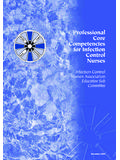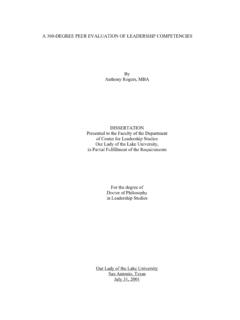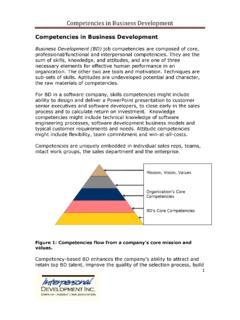Transcription of The Five Leadership Competencies: Secrets to …
1 2009 Sandy Blaha, David Rippe 1 The five Leadership competencies : Secrets to Successful Leadership Succession A White Paper January 2009 1st Edition Written by: Sandy Blaha David Rippe 2009 Sandy Blaha, David Rippe 2 The five Leadership competencies Success is based on one s ability to see the future and act decisively upon it. Whether your firm s transition to new Leadership is five years, ten years or twenty years out, to succeed with Leadership succession, every company needs to strengthen five major Leadership competencies . This white paper lays the preliminary groundwork for the learning the skills that support Leadership succession, as well as the development of key employees, high-potential employees, and the next-generation team. Right now, more people are retiring from their own businesses than ever before. At the same time, the next generation of business owners the thirty- five to forty-four year olds is fifteen percent fewer in number than those they are replacing.
2 Scary? Yes and no. For owners who are retiring (or who want to retire), the situation is a challenging one, but one that holds surprisingly good potential for outcome. These advancing entrepreneurs effectively managed will be forty-four percent more profitable and fifty percent more productive. The Corporate Leadership Council surveyed eight thousand leaders who report that people management skill is the most important attribute of effective leaders. Well-managed talent also typically produces fifty percent more client loyalty. Finding and keeping the right people to lead a company into the future frequently requires new skill sets. Management often overlooks staff with true entrepreneurial qualities and potential because young entrepreneurs do not always play by the rules. Using the Myers Briggs Temperament Instrument (MBTI), we are able to help key people identify natural entrepreneurial strengths.
3 Once identified, setting entrepreneurs on their success path will reap great benefits for the company. Doing so, however, involves an investment of time, energy, and resources. These energetic and ambitious individuals will need focused mentoring, training, and coaching. The long-term payoffs are critical and significant. These entrepreneurs will become fully committed to the business and will be the key players in the business growth. People, especially talented people, are any business most expensive resource. They are The five Leadership competencies Sandy Blaha, David Rippe 3 Sandy Blaha, David Rippe your currency of trade and key competitive advantage. To retain identified entrepreneurs, technical leaders, and managers, owners must realize the need to actively work on company performance as well as to remove barriers to individual performance. This requires an ongoing commitment to placing high potential talent in senior level positions within the company and giving them the opportunity with support, authority, and responsibility to succeed.
4 By constantly filling the leader pipeline in this way, outgoing owners can help ensure their return on investment. Developing the five Leadership competencies skills will further help ensure a workplace environment that retains the best talent. Effective management of talent means: Choosing the right individuals for your most critical roles Providing integrated interventions that support the succession of new leaders Developing pathways and empowering the next generation to be successful in those pathways Encouraging and rewarding high levels of performance Identifying, retaining, and managing top talent is hard enough. But business owners especially those who have built their companies from the ground up often find that the most difficult task is delegating authority. The process of empowerment takes on a new dimension when an owner must trust that the next generation will care for the business as well as he or she has.
5 The five Leadership competencies Now that we have established the imperative, we are ready to dive into each of the five competencies . The majority of the material for this white paper comes from our field-tested, battle-ready workshop The Failsafe Exit Strategy and from Stepping Stones a toolkit that includes strategic planning overviews, goal plan forms, vision statements, market sector research guidelines, and effectiveness tools. These best practices have proven successful in hundreds of firms nationwide. Additional material comes from Mastering the Rockefeller Habits. The five Leadership competencies Sandy Blaha, David Rippe 4 Sandy Blaha, David Rippe The five Leadership competencies are: 1. Conducting difficult conversations Breakdowns in communication will inevitably occur during the process of Leadership succession. Learning how to address them quickly and directly by utilizing a model for effective conflict resolution is critical.
6 If swept under the rug, the lump of issues will continue to grow larger and larger until people start tripping over them. 2. Letting go At the heart of letting go is the ability to delegate and share authority. Without delegation skills there is a hesitation even paralysis for owners who are not clear about who will do what, how they will do it, how fast they will do it, and exact expectations. This hesitation is normal and natural; there are effective ways to get beyond it. 3. Coaching and mentoring Learning to coach and develop your direct reports has everything to do with your success and that of your key personnel. To do so you must focus on the important and not just the urgent. Delegating work requires the complementary skill of coaching your understudies. To delegate is to accept the responsibility to coach performance. Coaching involves teaching and taking a stand for the delegate's success.
7 Learn to enjoy the process of advancing the career and development of your reports. As you do so, you will also advance your own career. 4. Strategic Planning There are four critical decisions every business must get right in order to succeed People, Strategy, Execution and Cash. There is also a definitive set of three fundamental habits that make it easier to manage your business. In addition, there are two drivers and one essential tool, which align everyone and get them on the same page. This highly acclaimed, proven 4-3-2-1 business framework produces the strategic direction and results every organization seeks. 5. Developing a cohesive vision for the future Successful succession means key people and high-potential employees own the company with their hearts and minds before ever being asked to own it with their wallets. To start the process, begin by inviting up-and-comers into the company s strategic planning process.
8 The five Leadership competencies Sandy Blaha, David Rippe 5 Sandy Blaha, David Rippe Conducting Difficult Conversations The First Leadership Competency We ve all had to face challenging issues and have had to conduct difficult conversations. Most, if not all of us, have tried to avoid confronting a coworker, peer, or subordinate. Avoidance seldom works out. In fact, the problem only gets bigger and unwieldy for everyone involved. When it comes to succession planning it is crucial to face some hard truths. So, what are some of those difficult conversations that are typical in the move from the first to the second generation? Imagine the current stockholders as the hub of a wheel. The entire company has revolved around this particular owner or a set of owners. As high potential talent matures, they start to look at each other, noticing for the first time what kind of decision-making, people skills, and judgment the other people around the table have.
9 They might ask, How do I feel about being a future partner with these people? Answering this question might prove to be a difficult conversation. These new leaders must be able to conduct all sorts of difficult conversations about their roles in working together, their responsibilities, and the expectations they have of each other. Next generation leaders also need to be able to make controversial business decisions at times to help ensure the health of the company. Many techniques are available to improve skills in this area. One highly recommended method is the creation of a study group with key employees using the book, Crucial Conversations . This material can be used in both your personal and professional life. It teaches you how to: Stay focused on your goals even when emotions run strong; Increase awareness of warning signs that a conversation is about to take a turn for the worse; Make it safe to talk about almost anything; Create healthy dialogue even when you feel scared, angry, frustrated or hurt; Say potentially hurtful things in a way that minimizes defensiveness; The five Leadership competencies Sandy Blaha, David Rippe 6 Sandy Blaha, David Rippe Listen effectively even when others blow up or clam up; Move successfully from discussing tough issues to taking healthy action.
10 We ve facilitated Crucial Conversations workshops as authorized instructors to our clients over the years. Many have stated that it is the single most powerful and effective thing they have ever done for their company. It is an essential tool. Once you have mastered how to conduct difficult conversations and learn to use it effectively with the other four competencies it is a proven, powerful process for aiding transition. Letting Go The Second Leadership Competency Now it s on to Letting Go. We know, two simple words, but very hard to implement. To successfully transfer power, a company must identify expectations, goals, roles, responsibilities, and know how to hold others accountable. Everyone must improve his or her delegation skills. In addition, owners must communicate who has authority and behavior must be consistent with that message. The people impacted by these changes must understand the process for accessing information and decisions.







